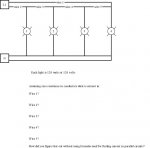John, I wouldn't hesitate to wire my house this way.In my opinion it is not a parallel circuit. I would not wire my house this way.
How many members of this fine Forum would wire a home in this manner ?
Roger
John, I wouldn't hesitate to wire my house this way.In my opinion it is not a parallel circuit. I would not wire my house this way.
How many members of this fine Forum would wire a home in this manner ?

310.4 explains all requirements to run conductors in parallel. It does not define what is in parallel.
The situation in the OP does not meet requirements or 310.4 but still has conductors installed in parallel to each other.
If this were a control circuit 310.4(A) would allow smaller than 1/0AWG to be connected in parallel. This happens very frequently with controls where a "OR" logic function is needed.
View attachment 5598
John, I wouldn't hesitate to wire my house this way.
Roger
The paralleled conductors in each phase, neutral, or grounded circuit conductor shall
(1) Be the same length
John, I have already said I have used ring circuits in landscape lighting.O K you wouldn't hesitate to wire your house with a ring circuit, but I would
venture a guess that you haven't done it.
So you can't see how it would solve VD problems in long or heavy loaded circuits?It's just a waste of wire & effort IMO.
It would not neccessarily be a "unique" solution.It would be a unique solution to some problems,
What danger would there be in doing so?but I just can't imagine a
whole house wired in ring circuits.
I did find a 2003 thread on the subject, but there was an older thread in the old forum whare we did agree it was a parallel circuit.
I didn't agree and still don't.
Roger
How do you figure?
Roger
The whole house is a parallel circuit.:thumbsup:
If you inspected this what would the violation be? Aside from two wires in one breaker I don't see any.
That said, I agree that this is a ridiculus waste of time and wire. BTW, why just the 15a circuits? There might be a voltage drop when the toster and blender are in use?
I know you were and do.Well I was joking but I do thin it is parallel.
I mentioned why earlier as did others. At every device the circuit is parallel-- I know this is an accepted practice in England and was often done with phones in this country but I still see it as parallel.
Plug a device in one receptacle and tell me what happens. Granted the wires are not the same length but that does not mean they are not parallel, IMO.
If a ring or loop is considered parallel conductors why wouldn't the NFPA refer to a Class A fire alarm circuit as conductors in parallel?
Roger
That would be allowed by exception 1 to 310.4(A).

